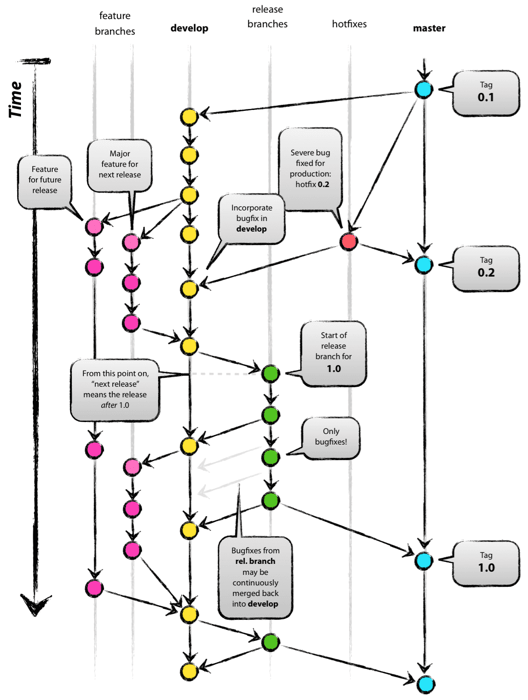Last time, we discussed Gitflow, Git Feature Branch, and Trunk-Based Development, which are all part of the Git version control system.
Today, we compare two commonly used workflows, GitFlow and GitLab Flow, which cater to different needs and approaches. This article breaks down their features, strengths, and weaknesses to help you make an informed decision.
GitFlow: Structured and Ideal for Scheduled Releases
GitFlow, created by Vincent Driessen, is a robust branching model perfect for projects with clearly defined release cycles. It provides a highly organized structure for managing features, releases, and hotfixes.
Key Features:
- Branches:
main: Holds production-ready code.develop: Tracks stable development progress.- Supporting branches: Feature, release, and hotfix branches for specific tasks.
- Workflow:
- Developers create feature branches from
developfor new features. - Completed features are merged back into
develop. - Release branches are created for finalizing and testing releases before merging into both
mainanddevelop. - Hotfix branches are used to address urgent issues in
mainand are merged back into bothmainanddevelop.
- Developers create feature branches from
Pros and Cons:
- Pros:
- Provides clear separation of development stages.
- Ideal for projects with predictable release schedules.
- Cons:
- High complexity can slow down teams.
- Less suitable for environments requiring frequent or continuous updates.
GitLab Flow: Simplicity for Continuous Delivery
GitLab Flow is a modern, streamlined approach optimized for continuous integration (CI) and continuous delivery (CD). It emphasizes simplicity and deployment readiness, making it popular for teams adopting DevOps practices.
Key Features:
- Branches:
- Minimal branching, with most work happening on
mainor short-lived feature branches. - Optional environment-specific branches (e.g.,
staging,production) for deployment workflows.
- Minimal branching, with most work happening on
- Workflow:
- Developers create feature branches and submit merge requests for peer review and automated testing.
- Approved changes are merged directly into
main. - CI/CD pipelines automate testing, integration, and deployment.
Pros and Cons:
- Pros:
- Simplifies branching and deployment processes.
- Encourages rapid iteration and frequent updates.
- Cons:
- Lacks structure for managing long-term parallel development.
- Relies heavily on robust CI/CD systems for success.
Quick Comparison: GitFlow vs GitLab Flow
| Aspect | GitFlow | GitLab Flow |
|---|---|---|
| Branching Model | Multi-branch (develop, feature, release, hotfix) | Minimal branching (main, optional environment branches) |
| Complexity | High | Low |
| Focus | Release management | Continuous delivery |
| Use Case | Scheduled releases, complex projects | Frequent updates, DevOps practices |
Choosing the Right Workflow
- Choose GitFlow if your project has clearly defined release cycles, involves long-term maintenance, or requires structured parallel workstreams.
- Choose GitLab Flow if your team operates in a fast-paced environment with frequent deployments and leverages CI/CD pipelines for efficiency.
Picture of the Day:
— Dr. Tree (@lannyland.com) January 4, 2025 at 1:08 PM
P.S. Remember, the easiest way to keep up with my journey is by visiting blog.lannyland.com


































































































































0 comments:
Post a Comment